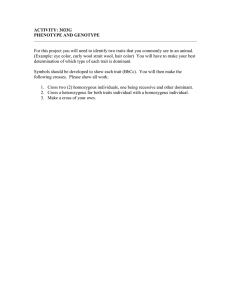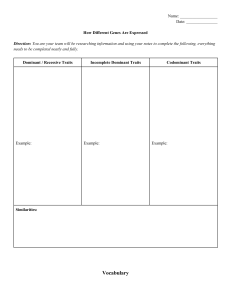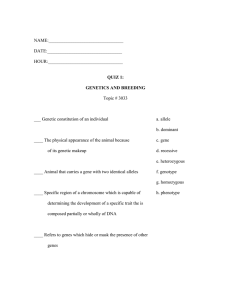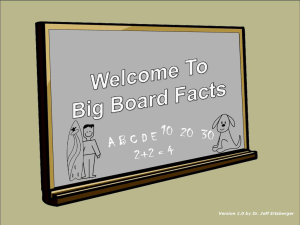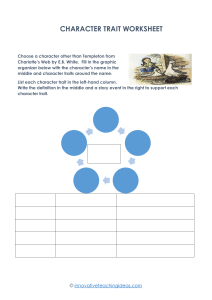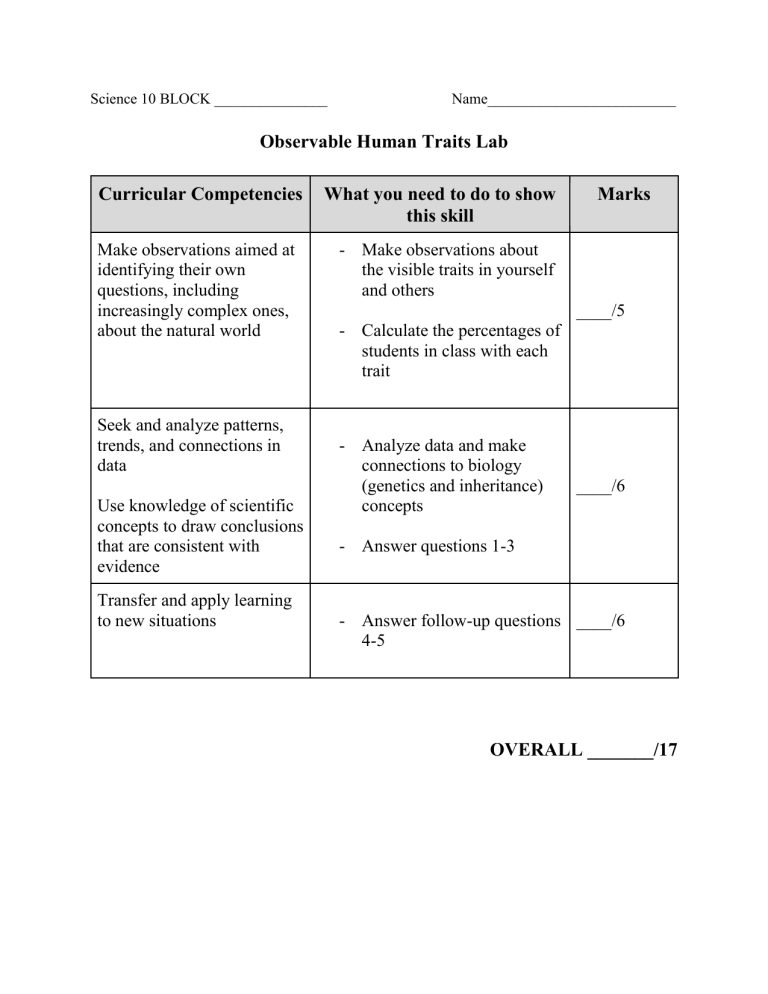
Science 10 BLOCK _______________ Name_________________________ Observable Human Traits Lab Curricular Competencies Make observations aimed at identifying their own questions, including increasingly complex ones, about the natural world Seek and analyze patterns, trends, and connections in data Use knowledge of scientific concepts to draw conclusions that are consistent with evidence Transfer and apply learning to new situations What you need to do to show this skill Marks - Make observations about the visible traits in yourself and others ____/5 - Calculate the percentages of students in class with each trait - Analyze data and make connections to biology (genetics and inheritance) concepts ____/6 - Answer questions 1-3 - Answer follow-up questions ____/6 4-5 OVERALL _______/17 Name____________________ Observable Human Traits Lab In the 1800s, Gregor Mendel performed breeding experiments on pea plants. His careful observations were the basis of modern understanding of genetics and inheritance. Certain traits in humans have two different variants (alleles). One allele is dominant and the other is recessive. A person can have three possible combinations of alleles; homozygous dominant, heterozygous, or homozygous recessive. Purpose of this lab: ______________________________________________________________________________ ______________________________________________________________________________ ______________________________________________________________________________ The following table has explanations for some easily observable traits in humans. Each has at least two alleles. 1. 2. 3. 4. Within your group, record how many people either show the trait or not. When done, add your group’s data to the class data table. Record the class data into Table 1 on your lab Calculate the percentage of students in the class who show and do not show each trait percent = number with the trait ÷ total number of students 5. Use this data to answer the follow-up questions Number of students in the class:________________ Table 1. Results of observable human characteristics. Trait Number of people with this trait % with trait Number of people without this trait % without trait Attached earlobe Tongue rolling Dimples Right handed Freckles Curly hair Widow’s peak Brown eyes Cleft chin Taste bitterness Follow-up Lab Questions: 1. Did any of the class results suggest that one trait definitely had a dominant allele? If so, which ones? How do you know? (2) ______________________________________________________________________________ ______________________________________________________________________________ ______________________________________________________________________________ ______________________________________________________________________________ ______________________________________________________________________________ 2. Did any traits show an equal percentage of students with each allele? What do you think this means? (2) ______________________________________________________________________________ ______________________________________________________________________________ ______________________________________________________________________________ ______________________________________________________________________________ 3. Is there a trait from this lab that you are sure you have either the dominant or recessive allele? Which one?______________________________________________________ Based on this, what can you assume about your biological parents' alleles for this trait? Explain your answer thoroughly. (2) ______________________________________________________________________________ ______________________________________________________________________________ ______________________________________________________________________________ ______________________________________________________________________________ 4. Explain, in detail, why you look different than your biological parents. And why do you look different than your siblings/other family members? (2) ______________________________________________________________________________ ______________________________________________________________________________ ______________________________________________________________________________ ______________________________________________________________________________ ______________________________________________________________________________ ______________________________________________________________________________ 5. Create 2 punnett squares for a cross between a person who can roll their tongue and a person who cannot. (2) a. Cross a homozygous dominant TT parent with a homozygous recessive tt parent. b. Cross a heterozygous Tt parent with a homozygous recessive tt parent. c. If those two people had four children, how would you know if the parent who could roll their tongue was homozygous or heterozygous? (2) ______________________________________________________________________________ ______________________________________________________________________________ ______________________________________________________________________________ ______________________________________________________________________________
